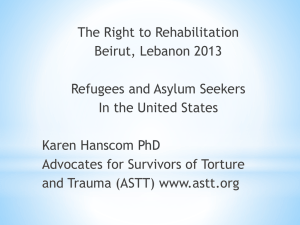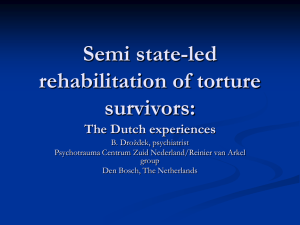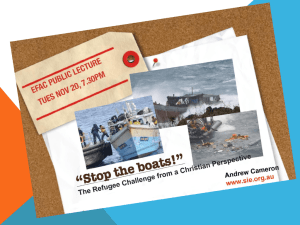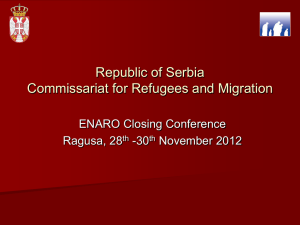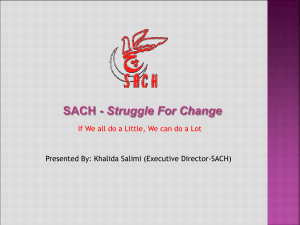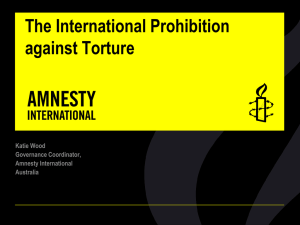Asylum Seekers Presentation
advertisement
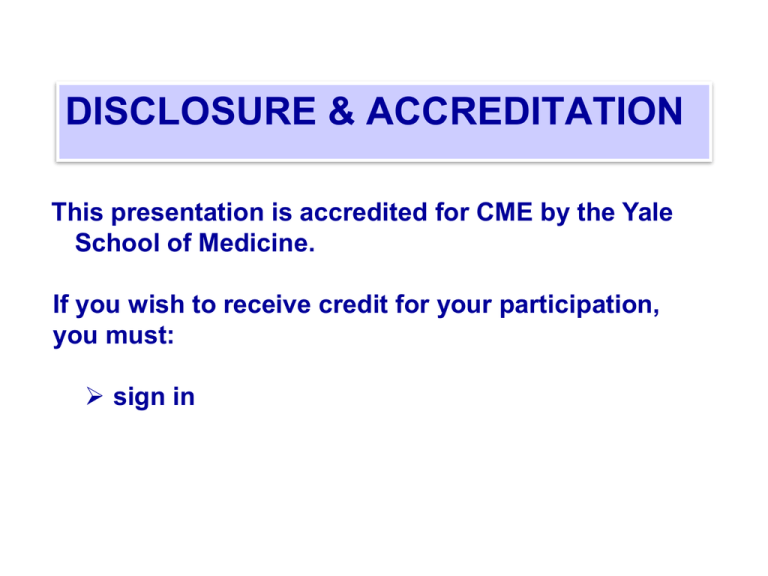
DISCLOSURE & ACCREDITATION This presentation is accredited for CME by the Yale School of Medicine. If you wish to receive credit for your participation, you must: sign in DISCLOSURE & ACCREDITATION Acknowledgement is made on behalf of the Section that: ~ There is no commercial support for this lecture Confirmation is also made that today’s lecture and faculty disclosure have been peer reviewed and: ~There are no conflicts of interest. Medical Forensic Evaluations of Asylum Applicants Photo: Robert Lisak Katherine C. McKenzie, MD Yale Center for Asylum Medicine Yale School of Medicine Asylum Applicants Photo: Robert Lisa “Clients” not Patients Medical Forensic Evaluations of Asylum Applicants • • • • • Asylum Torture Medical Evaluations at Yale Evaluation Process Asylum Cases Asylum According to the UN Universal Declaration of Human Rights (1948): “Everyone has the right to seek ….in other countries asylum from persecution.” “No one shall be subjected to torture or to cruel, inhuman or degrading treatment or punishment.” Asylum Applicants “An alien in the US …..who is ….unable or unwilling to return to his or her country because of persecution or…fear of persecution…..must be based on the alien’s race, religion, nationality, membership in a particular social group or political opinion….” US Immigration and Nationality Act 101 (a)42 Asylum Applicants •Every year, thousands of torture victims from other countries seek refuge in the US •Many are sent back to the countries from which they have come, as they cannot prove they were tortured •In 2012, almost 30,000 applicants were granted asylum in the United States •Medical forensic evidence substantially increases the likelihood that asylum will be granted (30% vs 85%) HealthRight International US Dept of Homeland Security Refugee versus Asylum Status • Refugee are admitted to US with legal status • Asylees enter with or without legal status HealthRight International Torture • Officially condemned by most nations • Continues to be carried out in almost 150 countries; it is widespread in more than 70 Examining Asylum Seekers, PHR UN General Assembly Convention Against Torture and Other Cruel, Inhuman and Degrading Treatment and Punishment (CAT) 1984 “Any act by which severe pain or suffering, whether physical or mental, is intentionally inflicted on a person for such purposes as obtaining from him or a third person Information or a confession, punishing him for an act he or a third person has committed or is suspected of having committed, or intimidating or coercing him or a third person, or for any reason based on discrimination of any kind, when such pain and suffering is inflicted by or at the instigation of or with the consent or acquiescence of a public official or other person acting in an official capacity. It does not include pain or suffering arising only from, inherent in or incidental to lawful sanctions. “ Convention Against Torture (CAT) •States must take effective measures to prevent and punish torture •[It] prohibits States from returning a person to a State where he or she is in danger of torture •[It] requires States to offer sanctuary to people who demonstrate that they could be tortured •No specific quota Torture vs Persecution Torture • Intentional infliction of severe mental or physical pain Persecution • Wider spectrum of hardships inflicted on an individual due to their race, religion, nationality, social group, or political opinions Torture vs Persecution • Torture is a form of persecution • Both qualify a client for asylum status Common Forms of Torture: Waterboarding or Suffocation Examining Asylum Seekers, PHR Common Forms of Torture • • • • • Burns Sexual assault (Rape, Female Genital Mutilation/Cutting) Forced positioning Suffocation/waterboarding Electrical torture Common Forms of Torture: Burns Common Forms of Torture: Lacerations/Cuts Doctors of the World 2009 Annual Report Common Forms of Torture: Blunt Trauma/Beating Examining Asylum Seekers, PHR Common Forms of Torture: Forced Positioning Examining Asylum Seekers, PHR Common Forms of Torture: Sexual assault Physical Sequelae • • • • Scars Chronic pain Infertility/sexual dysfunction Neurological injuries Psychological Torture • • • • • • Deprivation Humiliation Torture/persecution of others Threats/blackmail Harassment/interrogation Inhumane conditions of detention/imprisonment Psychological Sequele • • • • • • Anxiety Depression PTSD Failure to thrive Insomnia/nightmares Sexual dysfunction/dyspareunia/erectile dysfunction Female Genital Mutilation/Cutting (FGM/C) • Manifestation of gender inequality • Most common in Africa; also practiced in India and Middle East • Entrenched in social, economic, political and religious institutions • “Coming of age” ceremonies; usually ages 0-15 • Perceived social benefits to families outweigh harms (ostracized by society) • Ensure virginity, decreases female desire • Enhances male sexual pleasure FGM/C • Classified as follows: Type 1: Partial or total removal of clitoris and/or prepuce Type 2: As above, plus removal of labia minor and/or majora Type 3: Narrowing of introitus by suturing labia minoris or majoris, +/- clitoris excision (infibulation) Type 4: All other harmful procedures to genitalia: pricking, piercing, incising, scraping, and cauterization Medical Forensic Evaluations at Yale 1999-2013 Referring Groups • Yale Law School-Jerome N. Frank Legal Services Organization • Jean Koh Peters, Faculty advisor – Law students • University of Connecticut School of Law-Legal Clinic • Jonathan Bauer, Faculty advisor - Law students Referring Groups • Physicians for Human Rights • Private lawyers (pro bono) Referring Groups • HealthRight International-Human Rights Clinic • Private lawyers (pro bono) HealthRight International Medical Forensic Evaluations at Yale • Law school clinics Medical evaluations Medical consultation Mentoring • Advocacy groups Mentoring • Resident teaching Photo: Robert Lisak Role of Clinician Examiner Not responsible for: •Verifying identity of client •Confirming veracity of client’s testimony •Determining whether claims of persecution meet CAT criteria for torture •Predicting what would physically happen if client returned to their country •Deciding whether client qualifies for asylum Role of Clinician Examiner • Cannot provide medical care • Objectivity strengthens testimony given to court • Expert testimony, not advocacy work Evaluation Process • Arrival at US airport • Can enter society if have tourist visa • If no visa, may be sent to detention center Physicians for Human Rights Applicants Awaiting Asylum Decision • Cannot work legally • Not eligible for government assistance • Legal maneuvers can take years Evaluation Process • Referral from law school or advocacy group • Attorney provides client declaration or affidavit and country report • Translator arranged if needed Medical Evaluation Meeting with client Photo: Robert Lisak • Review/reiterate/expan d declaration • Physical exam • Document findings with photographs and/or body diagrams The Interview • Independent expert • Sensitivity, compassion, respect • Allow client to feel some control while reliving trauma in during the interview and exam • Elicit as detailed information as possible • Referral to mental health professional, if necessary Poor Recall/Inconsistent Memory • Traumatic brain injury • Sensory deprivation • PTSD/depression Physical Examination • • • • • Limit to area of body where scars exist Note unrelated scars Body diagrams Photographs Describe injury as well as treatment: medication, sutures, surgery, hospitalization Photo: Robert Lisak Physical Examination Physical Findings of Torture • Physical findings can provide important evidence • Key to distinguish non torture scars from those related to specific torture • Sometimes physical evidence is absent (especially in cases of rape) • Psychological symptoms can be powerful evidence Physical Findings of Torture • • • • • “Diagnostic of” “Consistent with/highly consistent with” “Typical of” “Not consistent with” “Nonspecific” Report • Write declaration/affidavit • Attorney review • Court testimony – Telephone – Cross examination Report December 2, 2008 UNITED STATES DEPARTMENT OF JUSTICE IMMIGRATION COURT In the matter of the Application for Asylum of DC Declaration of Katherine McKenzie, M.D. QUALIFICATIONS: I, Katherine C. McKenzie, hereby declare as follows: I am a General Internist and Assistant Professor of Medicine on the full time teaching faculty at Yale School of Medicine and a member of Yale Internal Medicine Associates for the last 14 years. Since 1999, our practice has interviewed and examined a number of applicants referred from both Yale Law School and the University of Connecticut Law School. I have used the material prepared by Physicians for Human Rights to aid in my evaluation of asylum applicants. I have also participated in training presented by Doctors of the World. My training as a Board Certified internist qualifies me to perform this kind of examination. INTERVIEW: I interviewed Ms. C in my office on Thursday, November 20, 2008. Ms. C speaks fluent English. HISTORY: Ms. C is a 31-year-old Tutsi woman from the city of Lubumbashi in the Democratic Republic of Congo (Congo). She is seeking asylum in the United States of America. While she was in Congo, she was abducted, beaten and raped by the Congolese Security Forces operating under President Laurent Kabila. She also witnessed the murder of her father by the security forces. . Asylum Cases • • • • DK-Raped, cut, burned, inhumane conditions DLJ-Beaten, cut, burned FT-FGM/C, domestic violence PM-Abducted, raped, beaten, interrogated Asylum Cases • • • • DK-Raped, cut, burned, inhumane conditions DLJ-Beaten, cut, burned FT-FGM/C, domestic violence PM-Abducted, raped, beaten, interrogated Client DK • • • • • • • • • Referred from Yale Law School From Guinea Member of opposition political group Chased and arrested while participating in an opposition rally Fell while being chased Taken to detention facility Interrogated/threatened Raped Burned on hip with hot iron, beaten Client DK Asylum Cases • • • • DK-Raped, cut, burned, inhumane conditions DLJ-Beaten, cut, burned FT-FGM/C, domestic violence PM-Abducted, raped, beaten, interrogated Client DLJ • • • • • • • • Referred by University of Connecticut Attacked by political enemies in Haiti Assaulted while 7 months pregnant Attackers threatened to burn her house down Beat and kicked her with fists and batons Arm cut with machete Burned on legs with ? hot iron Lost consciousness: due to head trauma vs psychological trauma Client DLJ • Uterine hemorrhage/cervical rupture/delivered baby prematurely/postpartum hysterectomy • Required hospitalization and transfusion • Sutures to right arm laceration • Burn care to arm • Disabled child • Sexual dysfunction Client DLJ Asylum Cases • • • • DK-Raped, cut, burned, inhumane conditions DLJ-Beaten, cut, burned FT-FGM/C, domestic violence PM-Abducted, raped, beaten, interrogated Client FT • • • • • • Referred from Yale Law School From Ivory Coast Muslim Arranged marriage to second cousin Chased by elders before FGM; injured leg on gate FGM immediately before marriage with no medical care and intercourse shortly after FGM Client FT • Chronic domestic violence and rape throughout the marriage • Polygamy • Three miscarriages, attributed to scarring related to FGM • One live birth: a daughter • Fled country because of fear of daughter undergoing FGM Client FT Asylum Cases • • • • DK-Raped, cut, burned, inhumane conditions DLJ-Beaten, cut, burned FT-FGM/C, domestic violence PM-Abducted, raped, beaten, interrogated Client PM • Referred by Physicians for Human Rights • Gay man living in Uganda, a society intolerant of homosexuality • Neighbors reported, “….unnatural things; it is unAfrican.” • Abducted from home Client PM • Taken to unregistered holding cell for 33 days • Inhumane conditions • Threatened with death if his homosexual activities continued • Beaten and interrogated • Exhorted to report partners • Gang raped Client PM You can look at a scar and see hurt, or you can look at a scar and see healing. -Sheri Reynolds For More Information http://medicine.yale.edu/intmed/genmed/asyl um/index.aspx www.physiciansforhumanrights.org www.amnesty.org www.healthright.org Acknowledgements YIMA administrative staff: Yvonne Augur, Theresa Harris, Hillary Marino, Beverly Shanks
